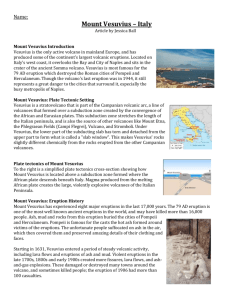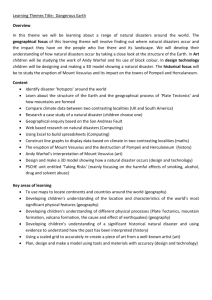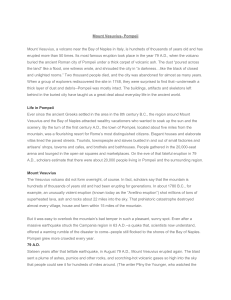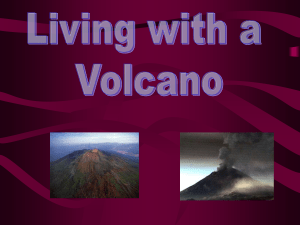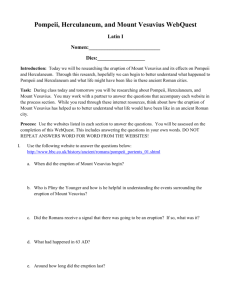Mount Vesuvius - WordPress.com
advertisement
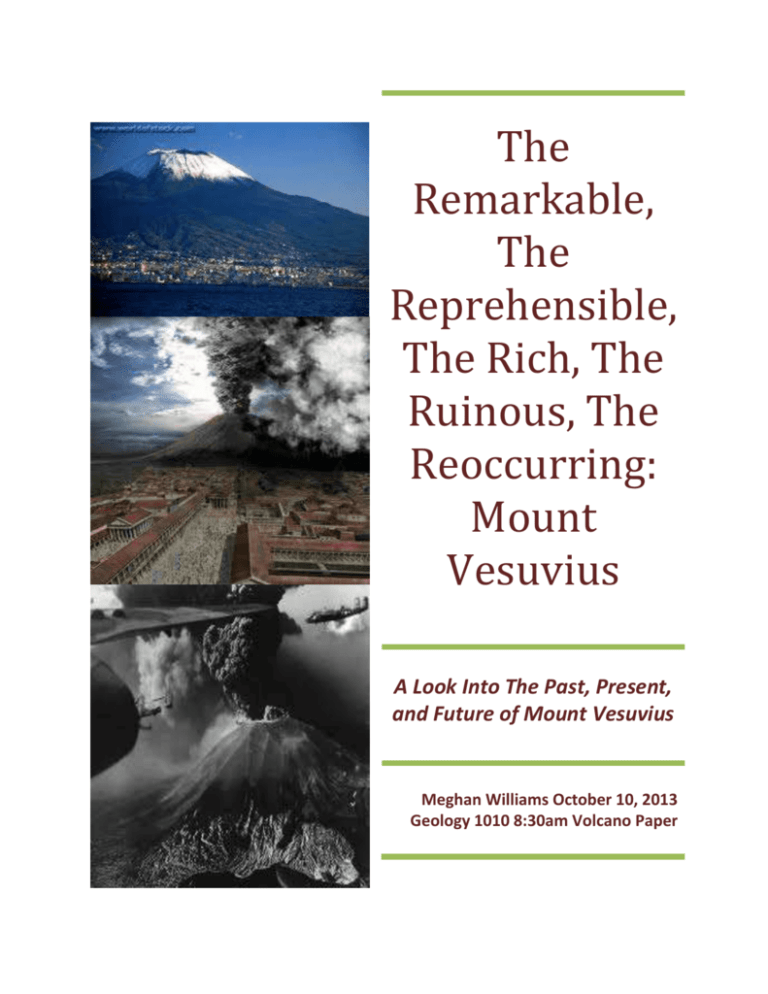
The Remarkable, The Reprehensible, The Rich, The Ruinous, The Reoccurring: Mount Vesuvius A Look Into The Past, Present, and Future of Mount Vesuvius Meghan Williams October 10, 2013 Geology 1010 8:30am Volcano Paper The Remarkable, The Reprehensible, The Rich, The Ruinous, The Reoccurring: Mount Vesuvius One of the most powerful geologic structures on our planet today, is the volcano Mount Vesuvius. This magnificent mountain is known for extremely ruinous eruptions that have buried entire cities multiple times. However, under the layers of sediment and ash deposits, these cities were preserved enabling us to discover the history of ancient civilizations that were completely destroyed. The largest and most widely known eruption was that of 79 AD. This was the famous eruption that buried Pompeii and Herculaneum. As well as the eruption of 79 AD, Mount Vesuvius is also known for its reoccurring eruptions that seem to have a pattern. This is particularly interesting when you take into account the 3 million people living in its shadow today (Havdverk); 700,000 of those millions living directly in “death zones” (Bohannon). Millions of people put their lives at risk everyday even knowing Mount Vesuvius’ history. Italians continue to settle on the slopes of this beautiful mountain because of its rich, fertile, soils which make it extremely easy to farm orchards and other foods. Are these civilians taking this volcano’s history lightly? Researchers have found that the likelihood of another eruption (soon), is extremely high. It is 50% more likely to erupt since the last major eruption, and growing every year (Sheridan). Many factors influence this theory, the geologic 2 The Remarkable, The Reprehensible, The Rich, The Ruinous, The Reoccurring: Mount Vesuvius characteristics of the mountain, the history, the new discoveries, and the knowledge of James Hutton’s theory Uniformitarianism; meaning that the physical, chemical, and geologic laws that operate today are the same laws that operated in the geologic past (TLT pg9). Taking all of these factors into account, we should be able to some-what predict the future behaviors of a volcano such as Mount Vesuvius. The general geologic characteristics of a volcano play a big part in understanding the great magnitude of its structure. Mount Vesuvius is found in the North Eastern side of the Bay of Naples, Italy. It stands upwards of 4,000 ft., and has two peaks of nearly equal elevation (Lobley). These peaks are known as Monte Somma (3,714 ft.) and Vesuvius (3,891 ft.). They are separated by an older crater known as “Val Del Inferno” or “The Valley of Hell” (Varone). The base is roughly 30 miles in circumference. Together they make up the entire Mount Vesuvius. This Volcano received its name based on the type of eruption it is known for, Vesuvian (also known as Plinian). These eruptions typically produce powerful convicting plumes of ash rising up to 10-20 miles into the stratosphere. This includes huge ash-falls, mud flows (lahars), and pyroclastic flow (Hall). Plinian eruptions typically involve felsic magma; however can occasionally occur in basaltic magma as well. Vesuvius is also, plentiful is a myriad of different minerals, some would be Aragonite, Calcite, Feldspar, Copper and Iron pyrites, Mica, Olivine, and several others (Lobely). These minerals help keep the soil fertile. The extremely rich soils suggest that there had been previous volcanic eruptions, considering volcanic ash enriches soil making it extremely nutritious for any and all plants. This is one of the main reasons it is so easy to justify settling and colonizing on the slopes of Mount Vesuvius. This colonization is what 3 The Remarkable, The Reprehensible, The Rich, The Ruinous, The Reoccurring: Mount Vesuvius made the eruption of 79 AD, and others, so memorable and tragic; the numbers of the casualties are hard to comprehend. Leading up to the great eruption, there were warning signs that a disturbance was happening. In the year 63, there was a great earthquake that damaged Pompeii and Herculaneum a great deal. There was also a second one the next year, however, these signs were ignored (Lobley). Before the eruption, a Greek geographer, Strabo, studied Vesuvius and emphasized the sudden change in appearance near the cone. He said it bore sinister witness to its ancient effusions. In fact, in one of Strabo’s passages of work, he refers to Mount Vesuvius as “The Eternal River of Fire” (Varone). The word ‘Eternal’ in that phrase emphasizes that fact that Mount Vesuvius will always remain cyclical in its reoccurring eruptions. Another ancient geographer Vitruvius, came to this same conclusion before Strabo had. They both drew comparisons between Vesuvius and Etna (a volcano in Sicily, Italy that is two and a half times the size of Mount Vesuvius and one of the most active and largest Volcanos of the world)(Varone). Even with these warnings, the people of Pompeii and surrounding cities still did not see the eruption coming. The great eruption of 79 AD is famous because it is the first eruption that we have a personal account recorded describing the event. This source is Pliny the younger’s experience. It began on August 24th, 79 AD. The first signs were ash billowing and smaller rocks raining down on the villages closest to the base. These rocks could get up to 90 mph causing some major injuries and damage. Soon after, the peak’s surface exploded. The violence of the explosion, known as a Boato, breaks the sound barrier. This releases 100,000 tons of 4 The Remarkable, The Reprehensible, The Rich, The Ruinous, The Reoccurring: Mount Vesuvius superheated rocks, ciders, ash, pumice, into the stratosphere reaching approximately 20 miles high (Hall). That is more than double the height of Mt. Everest (HCVid). Pliny the younger described seeing this explosion at noon that day. In his letters to a roman historian Tacitus, he described the cloud as an “Umbrella Pine Tree”. This type of eruption and cloud formation is now known as Plinian named after Pliny the younger (Hall). This cloud hovered over Pompeii and Herculaneum for around 12 hours. Winds carried some of the debris to neighboring towns such as Nola and Avellino which were hugely damaged as well. Suddenly the ash collapsed producing an apocalyptic sequence of events that makes Plinian eruptions on of the most lethal natural disasters on Earth (Hall). This collapse is called a Pyroclastic Surge. It creates boiling turbulent avalanche of debris that shoots out sideways from the slopes of the volcano. It travels for miles at great speed (Hall). Pumice and ash as hot as 1300℉ hurled toward the towns at 70+ mph destroying everything in its path. Over 200 sq. miles and 20,000 victims were affected by this catastrophe (HCVid). This pumice and debris can be baked in a subterranean magma chamber up to 1650℉. Because of this, the pyroclastic surge (or flow) is 100% lethal. It can travel with winds of 240mph and temps of at least 900℉, this would be hot enough to vaporize clothing and flesh in fractions of a second. The towns were left buried under ash and mud-flows. The countryside was covered up to 6 feet of ash in a 3 mile radius to 10 inches thick at 15 mile 5 The Remarkable, The Reprehensible, The Rich, The Ruinous, The Reoccurring: Mount Vesuvius radius ( 8 inches can cause a modern house’s roof to cave in) (Hall).According to the Pliny the younger, Herculaneum succumbed to its destiny many hours before Pompeii was destroyed. The eruption affected the different cities in different ways. Herculaneum was directly hit by the lahars and became completely buried (Varone). The after math of the eruption, once it was finished, was still just as destructive if not more. When the solid ash debris mixes with the steam by aquifers, it creates violent microclimate of thunderstorms and torrential rains. These storms produce more mud-flows just prolonging and increasing the damage. “More victims died from the mudflows than from the eruption itself.” Says Mastrolorenzo (a modern researcher) (Hall). Plinian eruptions are devastating. They consist of 6 deadly cycles; the blast, fallout, column collapse, surge, and the flow. The nature of this disaster created a unique situation. The ash and lahars perfectly preserved the towns destroyed in this event. In 1748 a farmer came across the remnants of Pompeii under is orchard (Bohannon). When further pursued by researchers, everything was found as though caught in their last moment; buildings, animals, even people. Hollowed, plater preserved human structures were initially believed that they suffocated from all the ash and debris. Recent studies show that that may not be the case. According to the research, it shows that instead of asphyxiation being the cause of death, it was rather flash-heat exposure that killed them instantly 6 The Remarkable, The Reprehensible, The Rich, The Ruinous, The Reoccurring: Mount Vesuvius (Valsecchi). Mastrolorenzo states, “Here to fore, archaeologists misinterpreted them as people struggling to breathe and believed they died suffocated by ashes, now we know that couldn’t be. The contorted postures are not the effects of a long agony, but of the cadaveric spasm, a consequence of heat shock in corpses.” By saying this, he is suggesting that the victims were frozen in suspended action (based on findings of curled toes, body orientation related to fleeing, etc.). The studies that Mastrolorenzo, Giuseppe, and colleagues preformed consisted of studying the layers of buried volcanic ash, and feeding the data into a simulation of Mount Vesuvius. They also studied modern day human and horse bones that have been exposed to high heats and found that the bones had the same markings and characteristics as the Pompeii victims bone remains. This means that the pyroclastic surges killed thousands in a fraction of a second (Valsecchi). By studying these human remains, and preserved aspects of these ancient civilizations, researchers have been able to map out and understand eruptions that happened before 79 AD. In the plains East of Naples, archeologists have found thousands of prehistoric footprints in a layer of volcanic ash (Lovett). The foot prints were made when the cooling ash was still fresh. All the footprints were heading in the same direction, away from Mount Vesuvius. This discovery is believed to be dated 2,000 years before Pompeii was destroyed in 79 AD. This eruption is known to have disrupted a huge bronze-age population (Lovett). Geologists have known about this event for decades; however they are just starting to understand the magnitude of this prior eruption. This eruption also caught this ancient civilization by surprise. The reason researchers came to this conclusion is they found abandoned animals (such as dogs and pregnant goats in stalls), abandoned dishes at the dinner table, etc. Researcher Sheridan 7 The Remarkable, The Reprehensible, The Rich, The Ruinous, The Reoccurring: Mount Vesuvius comments, “ The blast emitted four times as much ash and pumice as the 1980 eruption of Mt. St. Helens.” . They also found blast deposits of 3 meters thick (10 ft.) to support this theory. In comparison, the blasts from Mt. St. Helens leveled forests and the deposits were only I meter thick (3 ft.) (Lovett). This shows obvious evidence that there were plinian eruptions before 79 AD that were just as devastating. Sheridan has found that there is a pattern when it comes to Mount Vesuvius’ plinian eruptions; one happens approximately every 2,000 years (Hall): 25,000 years ago, 22,500 years ago, 17,000 years ago, 15,000 years ago, 11,400 years ago, 8,000 years ago, 3,780 years ago, 2,000 years ago (79 AD.). As Sheridan was explaining, according to history we are about due for another plinian eruption from Vesuvius. Presently is has been 2,000 years since that last plinian eruption, like stated earlier, the likelihood of another eruption is just growing every year, based on history. Sheridan claims, “Hazard planning is not taking these major events into account.” With being a researcher in that studies the impacts of eruptions in populated areas, in saying this he is trying to create a sense of urgency for the civilians living at the base of Vesuvius. History has shown it will eruptions will just keep happening. According to the more recent history of Vesuvius, there have been myriad of eruptions from Mount Vesuvius since 79 AD. Among some of the most important to record are (Lobely): 8 The Remarkable, The Reprehensible, The Rich, The Ruinous, The Reoccurring: Mount Vesuvius 472-Destoyed villages that were built on top of Pompeii, ash was even carried as far as Constantinople. 1036-The first record of fluid lava after which for 500 years Vesuvius was fairly dormant and surrounding volcanoes were violent (Etna). 1538-Monte Nuovo was thrown up. 440 feet in height with a crater just as deep. 1631-Great flow of lava no less than 7 streams, killed 18,000 1676-Perpendicular column of lava 1707-Violent ash eruption that shaded Naples in complete darkness 1760-New crater on mountain side opened. 1822-800 feet of cone blown away 1944-Last larger eruption These eruptions show how even in its “dormant” stages, Vesuvius is still deadly. On the otherhand, there is a possibility that the inevitable eruption might not be as disastrous as a traditional plinian eruption. There is a study, led by Bruno Scaillet of Universite d’Orlenas in France, which researches the rising magma in Vesuvius’ reservoir. According to Scaillet, because magma has been migrating toward the surface for over 20,000 years, there is a chance that the next eruption will be milder. A reservoir’s location and characteristics offer clues to the severity of future eruptions. Magma that pools at shallow depths is less volatile and less likely to produce violent eruptions (Handverk). In comparison, the deeper the reservoir, the colder the magma is being stored, and the more vicious the magma becomes. This type of magma is more prone to explosive eruptions by the time it reaches the surface (Handverk). Sheridan’s response to this research is that it was interesting. He obviously wasn’t convinced it was such great news. 9 The Remarkable, The Reprehensible, The Rich, The Ruinous, The Reoccurring: Mount Vesuvius He said it was not the last word on predicting the enormous risk factors associated with Vesuvius. We cannot be 100% sure on what kind of eruption is ahead of us. Even a milder eruption is still lethal; there isn’t much difference between 900℉ and 750℉. In conclusion, I don’t believe Mount Vesuvius is a volcano to overlook. It is not IF Vesuvius erupts again; it is WHEN Vesuvius erupts again. All we can do is try to prepare the best we can. We need to apply the knowledge we have learned about this magnificent mountain, and not let our cities be buried and forgotten once more. “The past is the key to the future” – John Hutton. This statement is true. When it comes to geologic laws, if it happened in the past, it will happen in the future. Mount Vesuvius has shown in a big way that it is not going anywhere, and it won’t be forgotten. 10 The Remarkable, The Reprehensible, The Rich, The Ruinous, The Reoccurring: Mount Vesuvius Bibliography Bohannon, J. (2003). Living in the Shadow of Vesuvius. Science, p. 299. Channel, H. (Director). (2006). Deconstructing History: Pompeii [Motion Picture]. Hall, S. S. (2007). Vesuvius Countdown-Asleep for Now. National Geographic. Handverk, B. (2008). Vesuvius Magma Chamber Rising:May Mean Milder Eruption. National Geographic. J. Logan Lobley, F. (1868). Mount Vesuvius: a Descriptive, Historical, and Geological Account of the Volcano. Edward Stanford/Charing Gross. Lovett, R. A. (2006). Huge Vesuvius Eruption Buried Town 2,000 Years Before Pompeii. National Geographic. Valsecchi, M. C. (2010). Pompeiians Flash-Heated to Death " No Time to Suffocate". National Geographic. Varone, A. (2004). Mount Vesuvius and the Eruption. In M. Panetta, Pompeii the History, Liffe, and Art of the Burned (pp. 400-410). 11
